![]()
![]()
![]()
Use LEFT and RIGHT arrow keys to navigate between flashcards;
Use UP and DOWN arrow keys to flip the card;
H to show hint;
A reads text to speech;
15 Cards in this Set
- Front
- Back
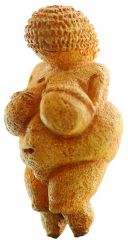
|
Venus of Willendorf
28,000-38,000 BC Paleolithic Early example of art, very small, probably fertility figure of some sort, very stylized emphasizing breasts, buttocks. Associated with Sympathetic |
|
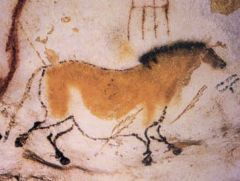
|
Hall of Bulls,Lascaux
15,000-12,000 BC Paleolithic Early example of painting, has similar essential characteristics of art as modern day, purpose unknown but clearly communal, probably ritualistic, probably sympathetic magic, bulls symbol of "male erotic fury" Sophisticated technique, eg twisted perspective |
|
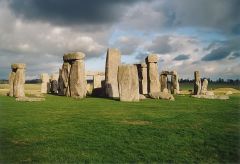
|
Stonehenge
2,500-1,600 BC Salisbury Plains, England Solar Observatory, sun aligns on solstice possibly agricultural calendar proximity of barrows indicates sacred, ritual space |
|

|
Presentation vase from Uruk
3,500-3,000BC Sumerian Demonstrates Sumerian attitude vis a vis gods, only priests could approach gods 3 distinct registers, hieratic scale |
|
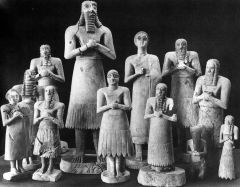
|
Votive Figures
2,800-2,600 BC Sumerian surrogates of worshipers placed in from of god in temple, because only priests allowed in temple clasped hands indicate supplication, wide eyes indicate awe of gods hieratic scale |
|
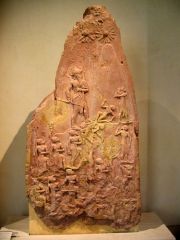
|
Stele of Naram-Sin
2254-2218 BC Akkadian Victory over the lullaby hieratic scale Ascending mountain, becoming closer to god because of divinity bull horns indicate divinity, virility |
|
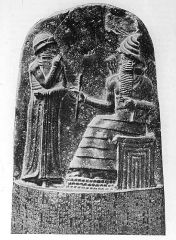
|
Stele of Hammurabi
1780 BC Babylonian carved with first codified law system god Chammash giving laws to Hammurabi, Divine right to rule Would have been placed in teh antechamber to audience hall as warning |
|
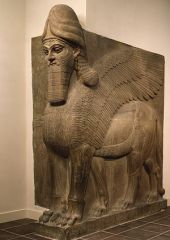
|
Lammassu
720-705BC Assyrian placed at entrance to Assyrian complexes placed to intimidate and as guardian figures composite of bull, bird of prey, human head |
|
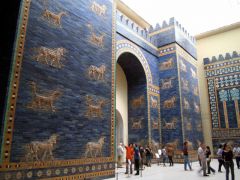
|
Ishtar Gate
575 BC Neo-Babylonian Testament to Babylonian glory mosaic of creatures sacred to ishtar, other gods |
|
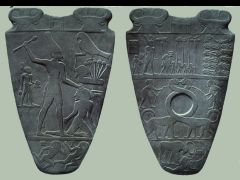
|
Palette of Narmer
3,100-3,000 BC Pre-Dynastic Palettes used to mix make up, this one purely ceremonial commemorates Narmer's unification of Upper and Lower Egypt Front depicts aftermath, combined crown Back depicts battle hieratic scale, Divine approval symbolized by horus giving a papyrus reed Hathor (patron goddess) at top Has his name written on it |
|
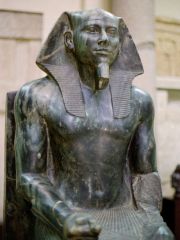
|
Khafre
2,500 BC Old Kingdom serdab, replacement body, shows Egyptian longings for permanence, diorite one with block, conforming to egyptian canon Horus embracing head |
|
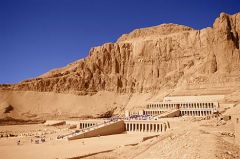
|
Temple of Hatshepsut
1473-1458 New Kingdom Located in Deir El Bahri Female Pharoah Organic architecture, integrated into site statues destroyed bys tepson |
|

|
Akhenaton Pillar Statue
1352-1336 Amarna Period Monotheism demanded fidelity to maat, or truth, religion worshiped only Aton |
|
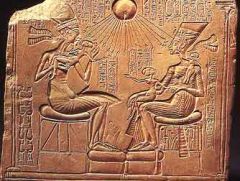
|
Akhenaton and His Family
1352-1336 BC aton blessing them, rays have hands bestowing ankhs, symbol of eternal life maat, monotheism, realism |
|
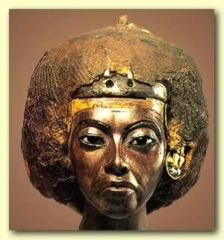
|
Queen Tiy
1352-1336 BC Amarna Akhenaton's mother realism/maat,can tell she is middle-aged stylized, headdress signifies royalty materials indicate royalty, yew wood inlaid with ebony and alabaster, earring is gold + lapis lazuli |

